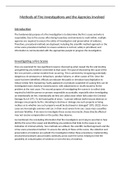Methods of Fire Investigations and the Agencies Involved
Introduction
The fundamental purpose of a fire investigation is to determine the fire's cause and who is
responsible. Due to fire scenes often being hazardous environments to work within, multiple
agencies are required to ensure the safety of investigators and preservation of evidence.
Therefore, procedural methods are deployed, including the scientific method approach or the
crime scene procedural method, to ensure evidence is not lost, safety is prioritised, and
information is communicated with the appropriate people to progress the investigation.
Investigating a Fire Scene
Fires are examined for two significant reasons: discovering what caused the fire and locating
and gathering any evidence connected to that cause. The goal of discovering the cause of the
fire is to prevent a similar incident from occurring. This is achieved by recognising potentially
dangerous circumstances or behaviours, product failures, or other causes of fire. Once the
cause has been identified, officials can educate the public or introduce laws/legislation to
reduce similar fires transpiring. Faulty appliances or products suspected of causing fires can be
investigated more closely by manufacturers, with adjustments or recalls issued to fix the
problem at the root cause. The second purpose of investigating fire scenes is to collect data
required to hold the person or persons responsible accountable, especially when investigating
an intentionally set fire. Intentionally set fires are called arson which falls under the Criminal
Damage Act of 1971. To be found guilty of arson, “a person without lawful excuse destroys or
damages any property by fire, intending to destroy or damage any such property or being
reckless as to whether any such property would be destroyed or damaged” (CPS, 2022). Arson
cases are increasingly common and can, in their most severe form can, cause mass casualties
and even fatalities. If we were to investigate these scenes incorrectly, those directly affected
may not receive compensation or the justice they deserve.
As mentioned, the concluding information that fire investigators are trying to ascertain is how
did the fire occur (the cause) and identifying any evidence that links to the cause or any
indication of criminal activity. Two methods are utilised, the scientific method approach and the
crime scene procedural method. To ensure the safety of those at the scene, the collection and
preservation of evidence are upheld; fire investigators follow these procedures. Implementing
structured procedures also provides continuity across each fire scene, helping to limit the
possibility of contamination of evidence or even the loss of evidence.
, Methods Deployed when Investigating a Fire Scene
Once the need for an investigation has been identified one of two methods are deployed to
investigate: the scientific method approach or the crime scene procedural method. The
scientific method approach extends further than the direct scene as it incorporates witness
statements, expert advice, and forensically analysed evidence to determine a cause of the fire
and who is responsible. Whereas the crime scene procedural approach is utilised to ensure that
evidence is collected and preserved at the scene for later analysis. While both methods are
beneficial in theory, if incorrectly conducted or incompletely applied, noteworthy evidence may
become admissible in a court of law. Additionally, concerning the crime scene procedural
approach the safety of those working at the time of the incident may be jeopardised.
Scientific Approach Method
One of the procedural methods used within a fire investigation is the scientific method. This
inquiry procedure serves as the foundation for investigations used by external agencies and
scientists in various areas. This method follows a clear structure in which the minimum amount
of detail and information may be overlooked. The scientific method approach follows eight
procedural steps, including recognising the need for an investigation, defining the problem,
collecting all the data, analysing the data, developing a hypothesis, testing the hypothesis, and
coming to a conclusion. This method relies on investigators “developing potential ignition
scenarios for the cause of a fire and then testing them against the evidence to see if these
scenarios are supported or refuted” (Ogle et al., 2003). Firstly, when recognising the need for an
investigation, the fire investigators are informed of an ongoing incident and “respond to the
scene to conduct a thorough fire scene examination” (NFPA, 2013). Defining the problem
follows this. During this stage, the fire investigators conduct a thorough examination of the
scene to determine any potential sources or accelerants present that had assisted the
development of the fire. Following this is data collection, where fire investigators should collect
all the facts and data recorded/documented. The data includes physical evidence, witness
interviews/statements, photographic evidence, fire patterns, forensic analysis reports. Once all
the case facts have been complied, they must be comprehensively analysed. Data analysis is a
critical phase that must occur before coming to a hypothesis. The data analysis is dependent on
the fire investigators expert knowledge and experience. Interpreting the data's significance will
allow the investigator to build hypotheses based on facts rather than pure speculation. When
all the cases facts have been analysed a hypothesis can be developed. The hypothesis should
explain the previously defined problem, including the origin of the fire, its cause and who is
responsible. The hypothesis will be considered inviable if it cannot withstand rigorous testing
through deductive reasoning. Testing the hypothesis is a vital stage in which the hypothesis is
either accepted or discarded, and a new hypothesis is formed and tested. Deductive reasoning
uses the investigator's knowledge, skills, and experience to test the possible hypothesis.




